Hengist And Horsa: Legendary Anglo-Saxon Warrior Brothers And Leaders Of First Settlers In Britain
A. Sutherland - AncientPages.com - According to very ancient poems, Odin's sons, Weldegg, Beldegg, Sigi, Skiold, Sæming, and Yngvi, became kings of Franconia, East Saxony, West Saxony, Sweden, Denmark, and Norway, and from them are descended the Saxons, Hengist and Horsa, and the royal families of the Northern lands.
 Hengist and Horsa arriving in Britain, by Richard Rowlands (1605). Public Domain
Hengist and Horsa arriving in Britain, by Richard Rowlands (1605). Public Domain
But one question is: who were the legendary warrior brothers Hengist and Horsa? Interesting is also whether they existed.
According to Anglo-Saxon tradition, these two heroes, Hengist and Horsa (meaning 'stallion' and 'horse'), were invited to Sub-Roman Britain by the British ruler Vortigern to help him defend against invading Scots and Picts attacking from the North.
After landing at "Wippidsfleet" (Ebbsfleet), Hengist and Horsa successfully drove off the invaders. It is said the two heroes played an essential part in the foundation of the kingdom of Kent.
Immediately after successfully fighting with the enemy, they received a land grant in Kent from Vortigern.
Hengist from John Speed's 1611 "Saxon Heptarchy". Image credit: Professor Liam Thompson - Public Domain
For ages after the arrival of the Saxons under the warlords Hengist and Horsa in 449 AD, the aboriginal inhabitants possessed the whole western coast of Britain. These people were engaged in continuous battles with the invaders.
Archaeological evidence has revealed traces of Germanic settlers in Canterbury in the late 300s; however, the main settlement probably took place in the 450s, under the leadership of the two warlord brothers, Hengest and Horsa.
Some historians have suggested that they are only mythical founding figures, divine twins like Romulus and Remus, rather than real people.
Hengest (also spelled Hengist) and Horsa are said to have been Jutes and sons of Wihtgils, a semi-legendary Jutish chieftain, according to the Anglo-Saxon Chronicle, one of the few literary sources for England's history during the period following the Roman presence and preceding the Norman invasion.
The brothers in Edward Parrott's Pageant of British History (1909). Image credit: Sir Edward Parrott - The Pageant of British History - Public Domain
According to the English historian and theologian Bede, the two brothers were Jutes, generally assumed to have come from Jutland in Denmark.
Hengest and Horsa arrived shortly after 449 with three shiploads of 'Angles or Saxons' at the invitation of Vortigern, king of the Britons (who flourished 425–450). They came to his allies to help him against the Picts, attacking from the North between 446 and 454 AD.
It needs to be specified, however, where, in Britain, this Vortigern had his seat. Was it located in the northwest, closer to the Picts region, or in the south?
The Chronicle also says that Hengest and Horsa fought against Katigern, the second son of Vortigern, near Epiford, and Horsa was killed at Aegelsthrep (possibly Aylesford, Kent) in 455.
The Venerable Bede mentions a monument to him located in east Kent; Horstead, near Aylesford, may be named for him; the Chronicle says that Hengist began to reign in 455 and that he fought against the Britons; it implies that Hengist died in 488.
Updated on Sep 19, 2023
Written by A. Sutherland - AncientPages.com Staff Writer
Copyright © AncientPages.com All rights reserved. This material may not be published, broadcast, rewritten or redistributed in whole or part without the express written permission of AncientPages.com
Expand for referencesReferences:
B. Yorke, Kings and Kingdoms of Early Anglo-Saxon England
More From Ancient Pages
-
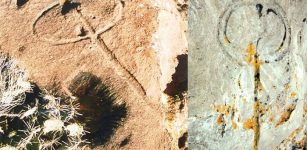 Puzzling Water Glyphs Of The American Southwest – Ancient Astronomical Symbols, Directional Signs Or Something Else?
Featured Stories | Apr 15, 2023
Puzzling Water Glyphs Of The American Southwest – Ancient Astronomical Symbols, Directional Signs Or Something Else?
Featured Stories | Apr 15, 2023 -
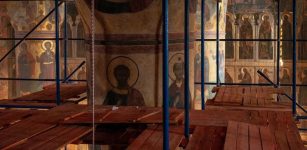 Never-Before-Seen Ancient Frescoes Discovered Inside The Dormition Cathedral
Archaeology | Feb 28, 2020
Never-Before-Seen Ancient Frescoes Discovered Inside The Dormition Cathedral
Archaeology | Feb 28, 2020 -
 Frightening Legend Of Tate’s Hell Swamp And The Curse Of The Native American Medicine Man
Featured Stories | Feb 12, 2022
Frightening Legend Of Tate’s Hell Swamp And The Curse Of The Native American Medicine Man
Featured Stories | Feb 12, 2022 -
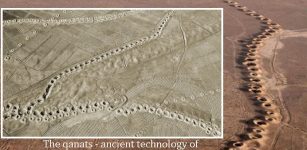 Qanats: Ancient 3,000-Year-Old Underground Irrigation Canals Invented By People Of Persia
Ancient Technology | Jul 13, 2020
Qanats: Ancient 3,000-Year-Old Underground Irrigation Canals Invented By People Of Persia
Ancient Technology | Jul 13, 2020 -
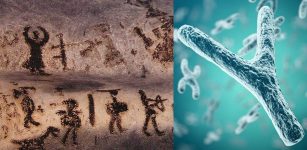 Puzzling Biological Event 7,000 Years Ago – Something Weird Happened To Men
Archaeology | Jun 1, 2018
Puzzling Biological Event 7,000 Years Ago – Something Weird Happened To Men
Archaeology | Jun 1, 2018 -
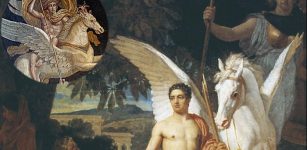 Bellerophon: Great Hero Of Homer’s Iliad Who Was Punished By Gods For His Pride And Arrogance
Featured Stories | Jul 13, 2021
Bellerophon: Great Hero Of Homer’s Iliad Who Was Punished By Gods For His Pride And Arrogance
Featured Stories | Jul 13, 2021 -
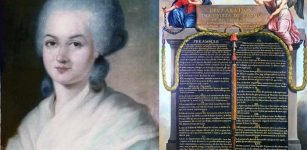 Olympe De Gouges – First French Feminist Challenged Maximilien de Robespierre And The Jacobins
Featured Stories | Nov 12, 2018
Olympe De Gouges – First French Feminist Challenged Maximilien de Robespierre And The Jacobins
Featured Stories | Nov 12, 2018 -
 Ambition, Greed And Death: The Roman Roots Of ‘Game Of Thrones’
Featured Stories | Jul 2, 2019
Ambition, Greed And Death: The Roman Roots Of ‘Game Of Thrones’
Featured Stories | Jul 2, 2019 -
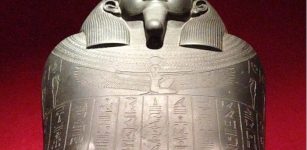 King Tabnit’s Sarcophagus And Its Surprising Forever-Lost Secret
Featured Stories | Jul 30, 2023
King Tabnit’s Sarcophagus And Its Surprising Forever-Lost Secret
Featured Stories | Jul 30, 2023 -
 First Animals On Earth Could Have Evolved Much Earlier Than The Oldest Fossils Suggest
Fossils | Oct 13, 2022
First Animals On Earth Could Have Evolved Much Earlier Than The Oldest Fossils Suggest
Fossils | Oct 13, 2022 -
 Ancient Sound Of Stones – Acoustics At Stonehenge Tested By Scientists
Ancient Technology | Aug 29, 2020
Ancient Sound Of Stones – Acoustics At Stonehenge Tested By Scientists
Ancient Technology | Aug 29, 2020 -
 Mysterious Stone Of The Sky God: Krishna’s Butter Ball Defies All Laws Of Physics
Featured Stories | Aug 20, 2014
Mysterious Stone Of The Sky God: Krishna’s Butter Ball Defies All Laws Of Physics
Featured Stories | Aug 20, 2014 -
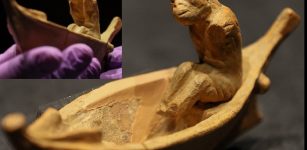 The 2,400-Year-Old Figurine Of Charon -The Ferryman Of The Dead – On Display In Izmir, Turkiye
Archaeology | Nov 21, 2022
The 2,400-Year-Old Figurine Of Charon -The Ferryman Of The Dead – On Display In Izmir, Turkiye
Archaeology | Nov 21, 2022 -
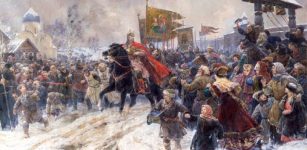 On This Day In History: ‘Battle On The Ice’ – Army Of Prince Nevsky Against Teutonic Knights Was Fought – On Apr 5, 1242
News | Apr 5, 2016
On This Day In History: ‘Battle On The Ice’ – Army Of Prince Nevsky Against Teutonic Knights Was Fought – On Apr 5, 1242
News | Apr 5, 2016 -
 Mesolithic Stone Mace Head Found Near Buckingham, UK
Archaeology | Apr 7, 2023
Mesolithic Stone Mace Head Found Near Buckingham, UK
Archaeology | Apr 7, 2023 -
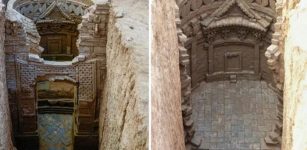 Incredible 700-Year-Old Tombs With Beautiful Decorations And Carved Bricks Found In Shandong, China
Archaeology | May 22, 2023
Incredible 700-Year-Old Tombs With Beautiful Decorations And Carved Bricks Found In Shandong, China
Archaeology | May 22, 2023 -
 Very Rare Ancient Roman Horse Brooch Discovered In UK
Archaeology | Mar 7, 2020
Very Rare Ancient Roman Horse Brooch Discovered In UK
Archaeology | Mar 7, 2020 -
 Sacred Number Six And Its Symbolic Significance In Ancient Cultures
Ancient Symbols | Dec 27, 2017
Sacred Number Six And Its Symbolic Significance In Ancient Cultures
Ancient Symbols | Dec 27, 2017 -
!["That most enduring of romantic images, Aristotle tutoring the future conqueror Alexander".[147] Illustration by Charles Laplante [fr], 1866](https://www.ancientpages.com/wp-content/uploads/2017/06/aristotleraslexanderlyceum-307x150.jpg) Aristotle: First Book Collector Who Assembled The First Great Library Of Antiquity
Featured Stories | Jun 23, 2017
Aristotle: First Book Collector Who Assembled The First Great Library Of Antiquity
Featured Stories | Jun 23, 2017 -
 Unexplained Phenomenon Around Yellowstone Puzzles Scientists
Featured Stories | Nov 12, 2018
Unexplained Phenomenon Around Yellowstone Puzzles Scientists
Featured Stories | Nov 12, 2018


